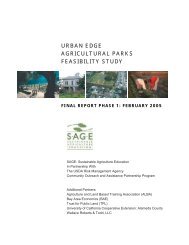A Feasibility Study for Urban Edge Agricultural Parks - SAGE
A Feasibility Study for Urban Edge Agricultural Parks - SAGE
A Feasibility Study for Urban Edge Agricultural Parks - SAGE
You also want an ePaper? Increase the reach of your titles
YUMPU automatically turns print PDFs into web optimized ePapers that Google loves.
INTRODUCTIONHistory of Collective FarmingThroughout the course of humanity, there have been many different models ofcommunal and collective agriculture. In order to provide some context <strong>for</strong> the<strong>Urban</strong> <strong>Edge</strong> <strong>Agricultural</strong> <strong>Parks</strong> <strong>Feasibility</strong> <strong>Study</strong>, the following brief history on someof the relatively recent historical models of collective and communal agriculture isprovided. Systems covered include sharecropping in the U.S., allotments in Europeand Asia, Ejidos in Mexico, Kibbutz in Israel, cooperatives in the U.S., the commonarrangement of a single landowner leasing parcels to multiple farmers, and finallythe broker or grower/shipper.The rise of capitalism and its spread throughout the world in the 15 th -20 th centuriescoincided with the demise of feudal systems. Feudal systems represented anancient <strong>for</strong>m of collective agriculture, which did not provide <strong>for</strong> an equitabledistribution of profits from production. The era of colonization throughout the world,which also coincided with the rise of capitalism and the demise of <strong>for</strong>mal feudalsystems, witnessed the rise in prominence of the slave trade. Sharecropping in theU.S. is commonly defined as a means of farming a small parcel of land owned bysomeone else with the requirement that the farmer must share the profits of thecrops sold with the landowner. In the U.S., sharecropping came to define themethod of land lease that would eventually become a new <strong>for</strong>m of slavery. Inmany countries throughout the world agrarian re<strong>for</strong>m attempted to more equitablydistribute land that could be used both <strong>for</strong> subsistence and commercial agriculture.In Europe and Asia, allotment systems have provided families, both rural andurban, an opportunity to conduct subsistence agriculture, as well has providingsociety with a way to create a buffer <strong>for</strong> food security in times of crisis. An analogycan be drawn between this type of allotment, the victory gardens of war time erasin the U.S., and the modern movement of urban agriculture, community gardens,food security and food sovereignty. Allotment gardens generally consist of a smallpiece of land between, often approximately 200-400 square meters in size. Japanhas developed a significant allotment system, in response to demand from largeurban populations and an intense competition <strong>for</strong> space. In Germany, small-scalefarmers and gardeners <strong>for</strong>med associations (like cooperatives) to help manage theirsmall plots. Communal management and water systems were established,including requirements to attend regular meetings where association memberswould report on progress towards their duties. Allotment associations in somecontexts have been shown to be an effective means <strong>for</strong> teaching and learning aboutdemocracy.DRAFT 1.6.05 10





